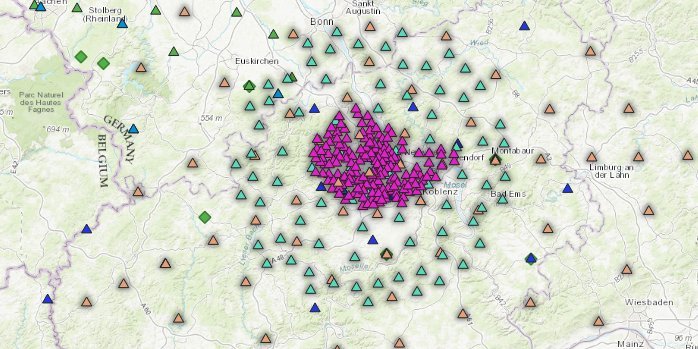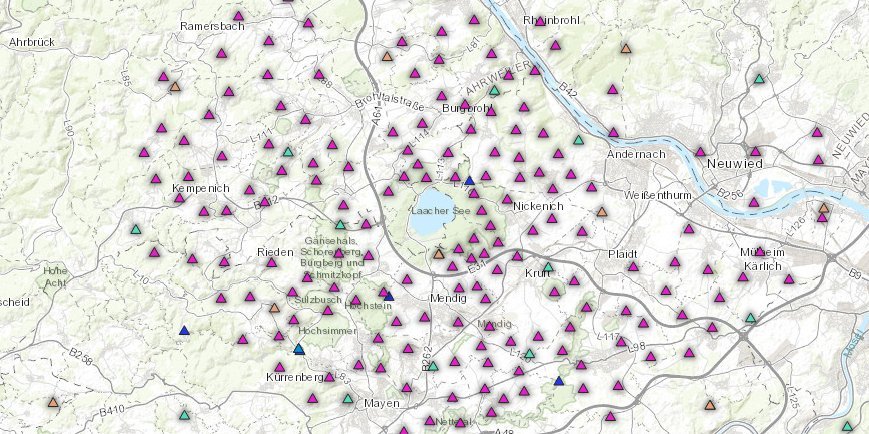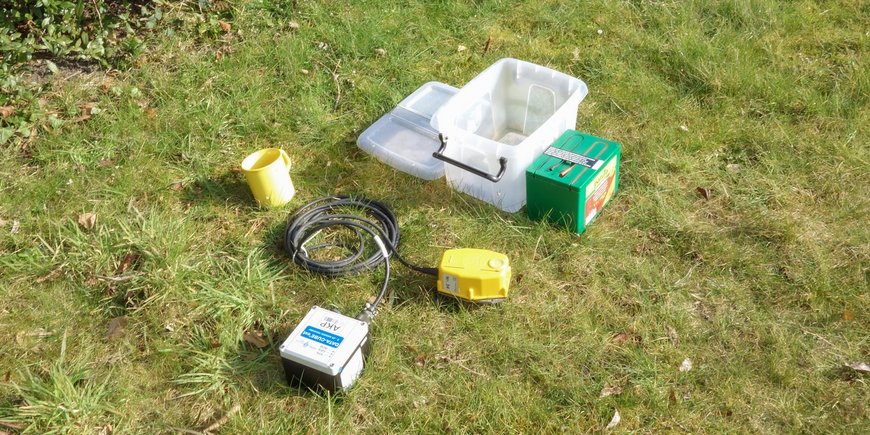Volcanism in the German Eifel region is actually considered extinct after the last major eruption about 13,000 years ago. However, low-frequency earthquakes measured there in recent years indicate that the subsurface has not yet completely quieted down. Researchers led by the GFZ German Research Centre for Geosciences are now trying to find out what the magmatic system under the Eifel looks like, whether volcanism there is only asleep after all, and how deeply asleep. A number of universities, international institutions as well as agencies and earthquake services of Federal States are involved. In the "Large-N" project, 350 geophones are currently set up in the region to measure underground tremors. Last weekend, Torsten Dahm, lead scientist from the GFZ, explained the project which is starting now in a presentation in Mendig, near the city of Koblenz, Germany.
The volcanism of the Eifel region
Volcanism has existed in the Eifel region for about 60 million years. Its effects are visible today as cinder cones, maars or craters. The approximately 800 Eifel volcanoes form a special form of distributed volcanism, which still puzzles scientists. There is, for example, the last great volcanic eruption about 13,000 years ago at Lake Laach: comparable in strength to the eruption of Pinatubo in 1991, traces can still be found in the sediments reaching as far as southern Sweden and northern Italy. Although the event was so large, it has not yet been possible to image and study the magma chamber of this volcano with seismic techniques. This is one of the specific goals of the Large-N experiment that is now starting.
The Large-N measurement campaign
Led by GFZ German Research Center for Geosciences, researchers want to study the subsurface much more precisely than has been possible up to now with a large-scale measurement campaign, hence the name of the experiment “Large-N” as “N” in the natural sciences stands for number – in this case, a large number of measuring instruments: Around 350 geophones will be set up in the Mayen-Koblenz and Ahrweiler districts.
Just as a microphone records sound waves in the air, the geophones record seismic waves underground. The experiment is expected to last about a year and will record both earthquakes and background noise. The dense measurement network enables a higher resolution in the observation, so the rock structures can be identified more precisely than before. Since the geophones continuously record the measurement data for more than a year, the volcanic processes in the subsurface can be characterized and monitored based on the localization of seismic signals better than previously possible.
“With this experiment, which is unique in Germany, we want to look deep below the earth's surface and find out what the subsurface is like and what happens there, i.e. observe the dynamics. Above all, it's about volcanic activity,” explains Torsten Dahm, Director of GFZ Department “Geophysics” and head of the project. In addition to eruptions, there are a number of phenomena that suggest volcanoes are not yet extinct.
Signs of ongoing activity: uplift of the Rhenish Slate Mountains and low-frequency deep earthquakes
For example, researchers have used high-precision global navigation satellite measurements to determine that the Rhenish Slate Mountains around the Eifel are uplifting. And there is a special type of seismic effect that the Earthquake Service Southwest, together with the GFZ and other partners, has been able to detect beneath the volcanic field of the Eastern Eifel: “deep low-frequency earthquakes (DLF)”. They were first detected in 2013 with the seismological network, which has been systematically expanded for ten years, and have been detected regularly since then. Studies at many other volcanic sites around the world show that DFL earthquakes are caused by fluids or gases in the solid rock. These fluids can be, for example, water, magma, or carbon dioxide. The low frequencies are generated by resonant vibrations in rock fractures, similar to the sound of an organ pipe.
The DLF quakes indicate that fluids are in motion, in this case from a depth of about 45 kilometers to the region of the Earth's upper crust. There are no “normal”, i.e., tectonic earthquakes in this region. Whether the DLF earthquakes are caused by magma chambers emptied in past eruptions filling up again, for example under Lake Laach, or whether it is just gases or water 'bubbling up', is – among other things – subject of the Large-N experiment.
Accompanying information for the local population
Wherever possible, the 350 measuring devices were set up in areas that belong to the public sector, such as municipalities. In some places, private citizens were also asked if they could have a geophone on their property for a year. The experience with this has been overwhelmingly positive. “People are very interested and very open to our research work,” says GFZ scientist Christoph Sens-Schönfelder. “It is therefore very important for us to keep the local citizens well informed about our research activities.”
No signs of impending volcanic eruption
This includes the volcanologists' reassuring assessment that people in the Eifel region need not be afraid of an imminent volcanic eruption at present: “Our research primarily serves to improve our understanding of the volcanic systems deep below the earth's surface in the Eifel region,” emphasizes project manager Torsten Dahm. “When we have a better understanding of the processes and conditions underground, we can compare the data with those from active volcanic areas. Then we can also better assess what the rumbling underground means – how deeply the volcano is asleep, if you will.”













![[Translate to English:] Torsten Sachs in front of a climate station on a field](/fileadmin/_processed_/3/9/csm__TorstenSachs_bearbeitet_GS_4a1365ef84.jpeg)

![[Translate to English:] left image flood at the Ahrtal: image from above, several houses are flooded; left image:: Heidi Kreibich;](/fileadmin/_processed_/4/4/csm_Bild2_9af0130e9f.png)



![[Translate to English:] Start der Vega Rakete](/fileadmin/_processed_/6/4/csm_20231201-kachel_Vega-VV23-launch_ESA-CNES-Arianespace_706716b68c.jpeg)









![[Translate to English:] Poster exhibition at the Brandenburg Hydrogen Day at the GFZ, some participants in the foreground](/fileadmin/_processed_/6/5/csm_Erster_Brandenburgischer_Wasserstofftag_GFZ_402fcec95e.jpeg)
![[Translate to English:] Group picture of the participants](/fileadmin/_processed_/9/4/csm_20231108_CAWa-Workshop-Tashkent_Gruppenbild_99ea779d8a.jpeg)

![[Translate to English:] [Translate to English:] Hörsaal](/fileadmin/_processed_/e/6/csm_H%C3%B6rsal_e21ac645fb.jpeg)


![[Translate to English:] The Delegations in the Historic Library on the Telegrafenberg. In the back there are from left to right, the Dutch Ambassador for Germany, Ronald van Roeden, the Dutch Minister for Education, Culture and Science, Robbert Dijkgraaf and the scientific director of the GFZ, Susanne Buiter.](/fileadmin/_processed_/d/b/csm_Kachel-2_9eba4b4212.jpeg)

